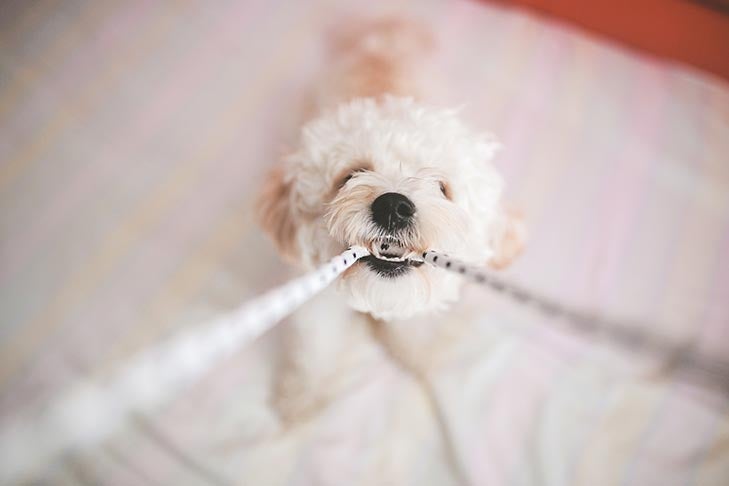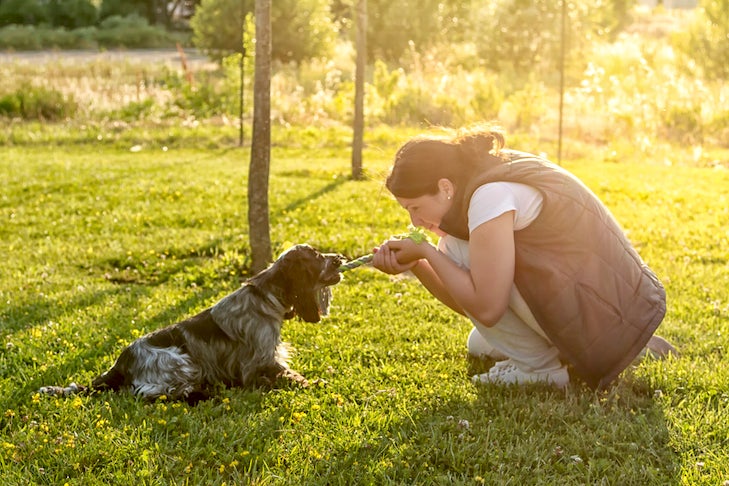What to do if your dog doesn’t release the toy on command.
If they don’t give up the toy easily on your request, don’t argue with them, but don’t let him win either. Keep hold of the tug toy and trade them for a treat. If necessary, drop the treat on the ground (or drop several treats) until they are tempted enough to drop the toy and eat the treats.
As soon as they drop the toy say the verbal cue ‘Mine’. Now continue the tug game again, but for a shorter period, and don’t encourage them to get so excited.
Many dogs are more willing to let go of the toy if they know they are going to get it back for another round of tug. If they continue to choose not to give when you ask him to, put the tug toy away while you work on the ‘Mine’ command.
How to play the perfect Tug of War game in 3 steps
1. Bring out the tug toy, shake it a little, and see if the dog will grab it. Pull gently on it to encourage them to resist. Always pull side to side and not backwards as you could hurt your dog. When they start to play reward them with “Good dog, tug!” As they get more enthusiastic about tugging, keep telling them “Good dog, tug!” and get more energetic with your tugging in response.
2. After five to ten seconds of tugging, stop moving. Still holding on to your end of the tug toy, stand still, and in a calm but happy voice say “Drop it!” or ‘Mine!”.
Remember: You are not intimidating the dog into giving you the toy—you’re just giving then information and asking the dog to respond with the appropriate behaviour. Because you have already trained the dog to give what they are holding to you when you say ‘Mine’, they will let go of the toy. When the dog releases the toy say ‘Yes!’ as a verbal reward.
3. Wait a second and then give the verbal command ‘Tug’ and continue to play the game.
Repeat 1-3 until you’ve both had enough!
Clubs Offering:
Does your dog love playing tug-of-war? Maybe you’ve stopped this type of game after hearing the mistaken belief that it encourages problem behaviors? However, speak to any top dog sports competitor or qualified trainer, and they will tell you that well-managed tug games have many benefits, and there are even scientific studies confirming they don’t promote aggressive or dominant behaviors.
Tug can promote impulse control, build confidence, and strengthen the bond between dogs and their owners. It’s an activity that taps into natural drives, making it a motivational, reinforcing, and high-value training tool. It is also a great way to burn off excess energy and keep your dog physically and mentally stimulated.
By letting your dog “win” during a game of tug, you aren’t letting them dominate you. Instead, you’re nurturing a solid rapport and teaching them that engaging with you is fun and rewarding. Dianna L. Santos (KPA-CTP, CPDT-KA, CNWI) is the Owner and Lead Instructor at the Dog Sport University. “I love the description of “shared holding” when it comes to tug. Allowing a dog to win means they can celebrate with their prize, but it also presents them with a wonderful opportunity: to choose to bring the toy back to you on their own!” she says. “It sounds so simple, but this is a huge shift from most interactions between dogs and handlers. Instead of the handler nagging their dog for the toy or the dog hoarding it away from them, the dog chooses to bring it back to play some more. This is liberating to the dog and can take your relationship to the next level!”

Tug can also build confidence and help your dog to focus on you in distracting environments. Dr. Erica C. Boling is a Certified Canine Fitness Trainer (CCFT) and owner of Northeast K9 Conditioning. She has used tug games with both her Belgian Malinois from an early age. “One of the things I did with my dog when he was younger, I would just put him in the car and take him to different environments, and I didn’t focus on obedience. Instead, it was like “let’s just go and play”, so he can see it is fun and, also, he learns to engage and focus on me versus being all distracted in the environment,” she says. “When he would get stressed and anxious, you could feel him releasing it during a game of tug.”
For dogs that struggle with impulse control, tug is a fantastic way to work on this. “Having a dog who will wait to go for the toy, or will drop it when asked, are crucial elements to the game,” explains Santos. “This ability for the dog to contain their excitement and still think is a skill they will need in day-to-day life as well!”
Santos describes tug as being an art. “Each dog and handler team will need to develop their own approach and technique. Knowing how to present the toy and interact with it, and your dog, during the tug session itself are important mechanical skills to master.”
When done correctly, tug sessions should be “kept relatively short (10-15 seconds), have impulse control built-in (dog should have a trained “OUT” or “DROP” behavior), and be something the dog is invited to do with you,” she says.
“Strive for two to three tugs in a session (tug-trade-tug-win-tug-trade) and then cap it off by asking the dog to do a “thinking” exercise. Give them a treat and then put the tug toy away,” Santos refers to this as interval training. “We allow the dog to get high up into the clouds with excitement and then bring them back down to earth with some fun thinking stuff. Being able to cap off their excitement is a skill every dog needs!”
Santos also points out that “choosing the right tug toy for your dog is key. Pick something that has some length to it (should the dog need to re-grip, they will not get your hand by mistake) and made of a material that is easy on their teeth and gums.”
It’s important to never chase after your dog if they run off with the toy or try to hoard or hide it. You are only teaching them not to listen to you, and they could become possessive of the toy. “The key thing here is that the reward in it is the engagement,” Boling reminds us. “I am going to chase you and you won’t bring it back, versus a dog that learns that, “oh no, when she lets go, the game is over, and I can’t do anything unless I bring it back to her.””

Another key element with tug is making sure you are not playing too rough or too long. Boling has seen many injuries caused by using incorrect techniques or playing tug when a dog has an existing injury. “I have an online canine fitness academy, and students have shared common practices they have seen during tugging that make me cringe,” she says.
There are a couple of things she always advises. “Number one is I recommend you try to keep the spine in a neutral alignment. I see a lot of people that will take the tug, and they are just yanking it up and down, the dog’s feet are coming off the ground, and the neck is all contorted and twisted.”
Secondly, Boling also recommends that you moderate the pressure based on the type of dog. There should only be light resistance when playing tug with young puppies or with senior dogs who might have physical issues, and they should engage with the toy more than you do.
When it comes to dogs involved in high impact sports or other exercise that is hard on the body, Boling also points out that “there might be issues going on in the neck or the spine, and we don’t really know because a lot of these dogs don’t easily show pain.” Always be vigilant for the subtle signs of pain, get your dog checked out by a vet if you have any concerns, and, as Boling reminds us, “be extra careful and think of neutral spine, neutral spine. Try to keep the dog in alignment, keeping those feet low on the ground, and adjusting the pressure.”
Of course, not every dog is motivated by this type of game. For some, a different type of toy, a tasty food morsel, or even praise is a better reward. It is usually the highly energetic, focussed breeds that enjoy tug. Those with working drives, like Belgian Malinois, Collies, Bully breeds and Terriers, are often fans.
Will playing tug of war make my dog aggressive?
Laika and I play a game of tug of war nearly everyday — it’s physically tiring, mentally stimulating, and just plain fun. And despite an old popular myth, tug does not cause aggression in dogs.
If you’re looking for a fun game to play your dog try adding in a game of tug to your dog’s daily routine. Tug is mentally and physically tiring for dogs, and it’s a great way to strengthen the bond you have with your dog. Here’s the benefits of playing tug with your dog.